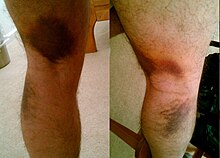


The biceps femoris long head is at the most risk for injury, possibly due to its reduced moment of knee and hip flexion as compared to the medial hamstrings.
There have been many other proposed predisposing factors to injury. These include muscle weakness, muscle imbalance, poor flexibility, fatigue, inadequate warm up, poor neuromuscular control, and poor running technique. One of the few predisposing factors that most researchers agree upon however is previous hamstring injury. The athletes most at risk of a hamstring strain are those with a previous history of such injury.

Sensation of cramp or tightness and a slight feeling of pain when the muscles are stretched or contracted.
With a grade two hamstring strain there is immediate pain which is more severe than the pain of a grade one injury. It is confirmed by pain on stretch, swelling and contraction of the muscle.

A grade three hamstring strain is a severe injury. There is an immediate burning or stabbing pain and the individual is unable to walk without pain. The muscle is completely torn and there may be a large lump of muscle tissue above a depression where the tear is.
After a few days with grade two and three injuries a large bruise may appear below the injury site caused by the bleeding within the tissues.
Recommended treatment for this injury consists of the RICE protocol — rest, ice, compression and elevation. The RICE method is primarily used to reduce bleeding and damage within the muscle tissue. Lower grade strains can easily become worse if the hamstring is not rested properly. Complete ruptures require surgical repair and rehabilitation.
Initial treatment of the injury, regardless of the severity of the strain, is the same. Within the first five days, the hamstring is rested in an elevated position with an ice pack applied for twenty minutes every two hours. A compression bandage is applied to limit bleeding and swelling in the tissues. After five days of rest, active rehabilitation begins.
|
Page Content |